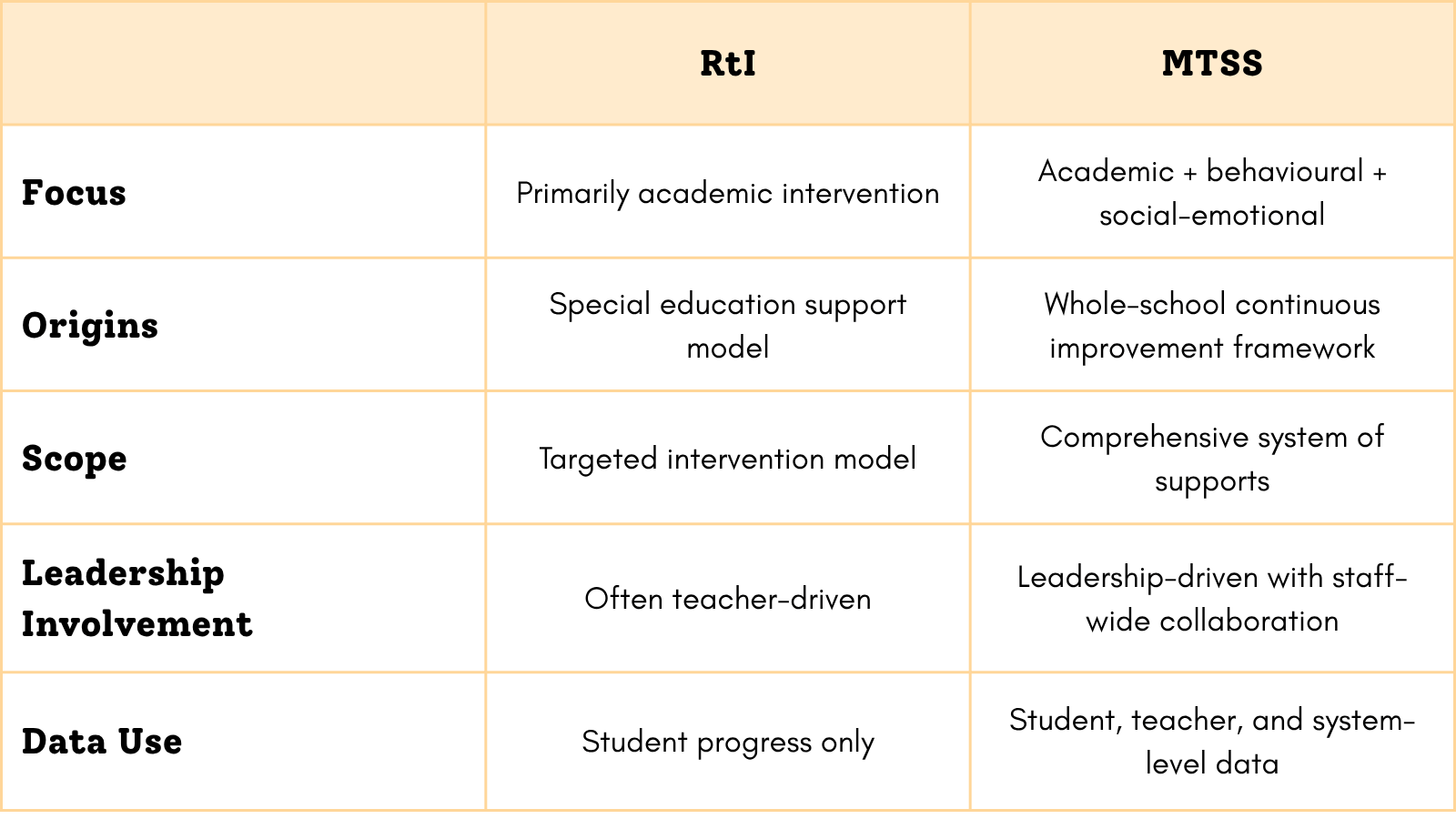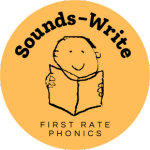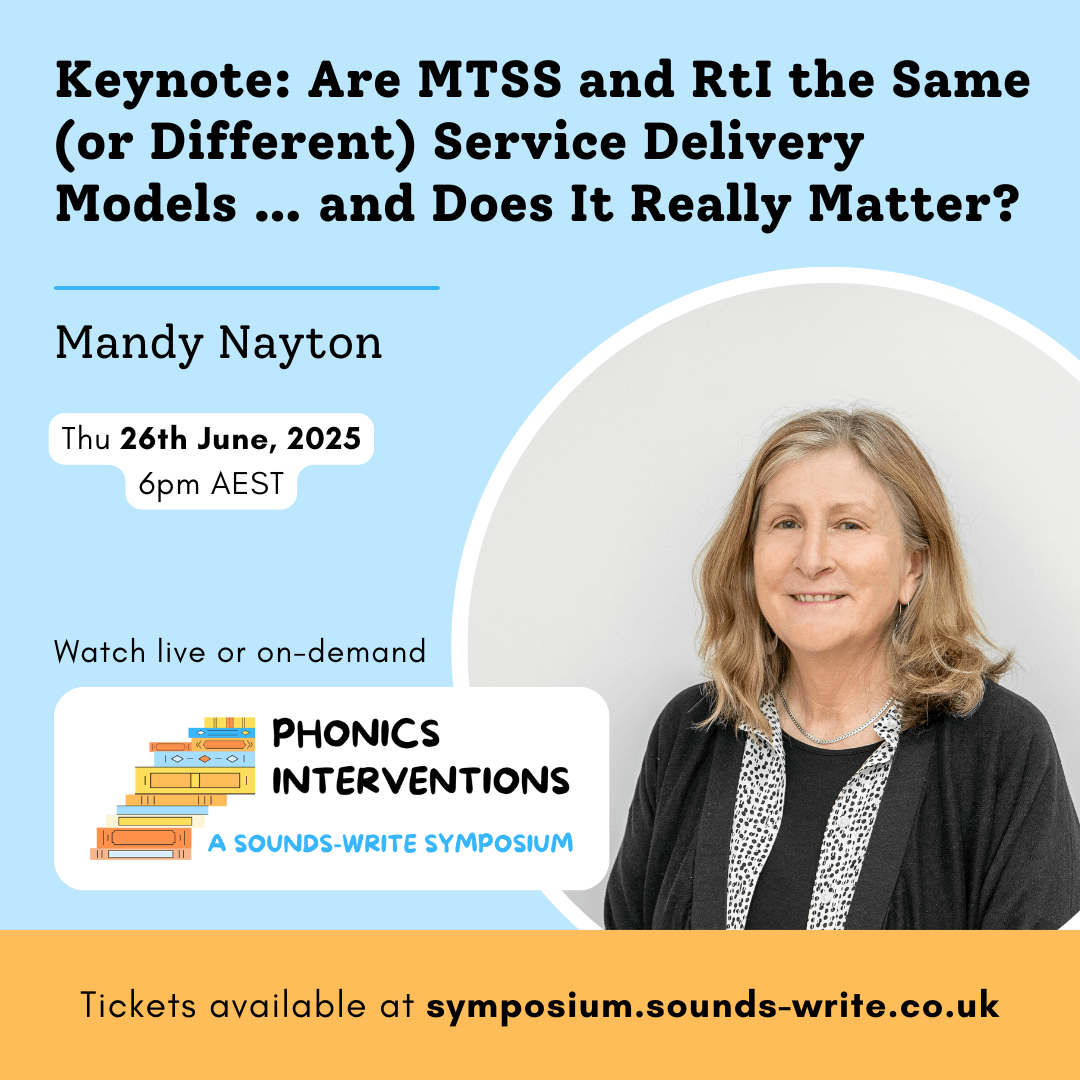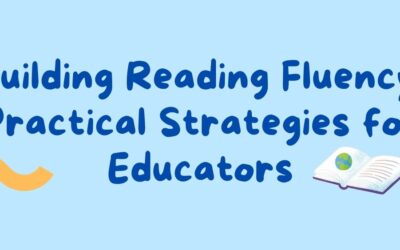At this year’s Sounds-Write Symposium, Mandy Nayton, CEO of DSF in Western Australia, delivered a keynote that brought clarity to a question many educators grapple with: What’s the difference between MTSS and RtI—and does it really matter?
Spoiler alert: Yes, it does.
Let’s break it down.
Why this conversation matters
Before diving into definitions, Mandy reminded us of something simple, yet deeply insightful:
‘The normal curve is not sacred. It describes the outcome of a random process… If our instruction is effective, the achievement distribution should be very different.’ (Bloom, 1971)
In other words, our job as educators is to move students beyond the norm, not just accept it.
That means designing support systems that are proactive, data-informed, and equitable—which is where MTSS and RtI come in.
Sounds-Write Symposium 2025
Purchase an All Access Pass to receive lifetime access to over 30+ talks from experts in literacy and education.
What is RtI?
Response to Intervention (RtI) is a framework designed to identify students who are struggling and respond with increasingly targeted interventions. It usually includes:
- Three tiers of support
- Tier 1: High-quality classroom instruction for all
- Tier 2: Small group interventions for students who need more support
- Tier 3: Intensive, individualized support
- Universal screening to catch problems early
- Progress monitoring to track whether interventions are working
Originally rooted in special education, RtI is now used more broadly to help prevent failure before it happens.
What is MTSS?
Multi-Tiered System of Supports (MTSS) includes everything in RtI—and more.
Think of MTSS as RtI 2.0, with a more comprehensive lens:
- It includes academic, behavioural, social-emotional, and even attendance-related supports
- MTSS considers whole-school systems: leadership, culture, and resource allocation
- There’s a strong emphasis on collaboration and data-based decision-making across all levels of the school
Mandy described MTSS as a way to build consistent, scalable, and sustainable structures that support all learners—not just those falling behind.
So, what’s the difference?

Why it matters for your classroom
Mandy emphasized that effective instruction and systems work hand-in-hand. You can’t patch gaps with Tier 2 or Tier 3 if Tier 1 isn’t rock solid. She pointed to factors that influence student achievement—like teacher knowledge, curriculum coverage, attendance, and instructional feedback—as critical levers in both frameworks.
More than just acronyms, MTSS and RtI are about changing lives through structured, responsive teaching.
Key takeaways for educators
- Use data as a flashlight, not a hammer: Identify needs early and adjust instruction based on what you see.
- Focus on Tier 1 first: Ensure high-quality, evidence-informed instruction is happening for everyone before moving students into intervention tiers.
- Feedback matters more than marking: Mandy reminded us that timely error correction has a greater impact than red pen.
- Stay consistent: MTSS isn’t a program—it’s a mindset and system. Consistency across staff is key.
Final Thought
Let’s look again at the Bloom quotation in full:

…the normal curve is not sacred. It describes the outcome of a random process. Since education is a powerful activity in which we seek to have students learn what we teach, the achievement distribution should be very different from the normal curve if our instruction is effective. In fact, our educational efforts may be said to be unsuccessful to the extent that student achievement is normally distributed’
Bloom, 1971
We’re not here to maintain the curve—we’re here to shift it.
Understanding MTSS and RtI is a step toward ensuring every child gets what they need to succeed. Whether you’re a classroom teacher, literacy coach, or school leader, these frameworks give us a way to do better—for all our learners.
🗣️ Focus on phonics: discussion questions for practitioners
- In what ways can you make your Tier 1 phonics instruction more consistent and explicit across year levels?
How can programs like Sounds-Write help you to ensure every student receives strong foundational teaching from the start? - Mandy quoted Bloon: ‘The normal curve is not sacred.’ What do you think this means in the context of teaching phonics in your classroom or school?
Do you teach for average outcomes—or are you shifting the curve? - How do you currently identify students who need Tier 2 or Tier 3 support?
Do you rely on formal assessments, teacher observation, or something else? Is there room to strengthen your use of data for early intervention? - What role does immediate, specific feedback (especially error correction) play in your current teaching practice?
How confident do you feel in providing responsive teaching (formative assessment) during phonics lessons? - What do you see as the key differences between RtI and MTSS in your day-to-day practice?
Where does your school currently sit on the RtI–MTSS continuum? - If Tier 1 is the foundation of student success, what specific elements of your core instruction might need refining?
Is it time allocation and planning? Teacher knowledge and staff training? Curriculum resources? If you’re a Sounds-Write practitioner, don’t forget that support is available—reach out to your trainer to discuss any challenges or areas of concern. Booking a call could provide valuable insight and guidance.
You may also like
Building Reading Fluency: Practical Strategies for Educators
Fluency is often described as the bridge between learning to decode and reading with true comprehension. But what does fluency really involve and how can teachers best support it in the classroom? In our recent Sounds-Write webinar, Reaching Fluency, Practical...
Author Q&A: The Vision Behind The Outdoor Adventures Decodable Series
At Sounds-Write, we’re passionate about creating high-quality, age-appropriate resources that support structured literacy and empower every learner. In this Q&A, we speak with Moira Ruff, author of The Outdoor Adventures, part 1 & part 2, our newest series of...
Illustrator Q&A: Bringing the Outdoor Adventures to Life Through Art
Behind every great story is a visual world that helps readers connect, imagine, and learn—and in The Outdoor Adventures series part 1 & part 2, that world is brought to life through the expressive work of illustrator Emma Pringle. With a lifelong passion for...





